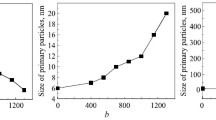Abstract
Zirconia-and scandia-based complex solid solutions predominantly with a monoclinic structure are prepared by mechanochemical synthesis. The dense ceramic materials, which, for the most part, have a cubic structure with grain sizes of 250–400 nm and possess good mechanical properties, are produced by sintering submicron fractions of the powders under relatively mild conditions at temperatures of 1633–1653 K. It is revealed that the powders are characterized by nanostructuring due to the complex composition and the chemical inhomogeneity. This nanostructuring is partially retained upon rapid sintering of the ceramic powders. The nanostructured ceramic materials possess a high low-temperature conductivity, which decreases after annealing. Unlike conventional ceramic materials, the nanostructured ceramic materials have identical activation energies for bulk and grain-boundary electrical conduction. The high-temperature electrical conductivity of the nanostructured ceramic materials is rather low because of the small grain sizes and impurities of the monoclinic phase.
Similar content being viewed by others
References
Kosacki, I., Anderson, H.U., Mizutani, Y., and Ukai, K., Nonstoichiometry and Electrical Transport in Sc-Doped Zirconia, Solid State Ionics, 2002, vols. 152–153, pp. 431–438.
Cai, Z., Lan, T.N., Wang, S., and Dokiya, M., Supported Zr(Sc)O2 SOFCs for Reduced Temperature Prepared by Slurry Coating and Co-Firing, Solid State Ionics, 2002, vols. 152–153, pp. 583–590.
Lee, D.-S., Kim, W.S., Choi, S.H., Kim, J., Lee, H.-W., and Lee, J.-H., Characterization of ZrO2 Co-Doped with Sc2O3 and CeO2 Electrolyte for the Application of Intermediate Temperature SOFCs, Solid State Ionics, 2005, vol. 176, pp. 33–39.
Zyryanov, V.V., Mechanochemical Ceramic Technology: Capabilities and Prospects, in Mekhanokhimicheskii sintez v neorganicheskoi khimii (Mechanochemical Synthesis in Inorganic Chemistry), Avakumov, E.G, Ed., Novosibirsk: Nauka, 1991 [in Russian].
Zyryanov, V.V., Processing of Oxide Ceramic Powders for Nanomaterials Using High-Energy Planetary Mills, Interceramics, 2003, vol. 52, no. 1, pp. 22–26.
Zyryanov, V.V., Sysoev, V.F., Boldyrev, V.V., and Korosteleva, T.V., A Technique for Processing Dielectric Materials, USSR Inventor’s Certificate no. 1 375 328, Byul. Izobret., 1988, no. 7, p. 39.
Zyryanov, V.V., Sadykov, V.A., Uvarov, N.F., Alikina, G.M., Lukashevich, A.I., Neophytides, S., and Criado, J.M., Mechanosynthesis of Complex Oxides with Fluorite and Perovskite-Related Structures and Their Sintering into Nanocomposites with Mixed Ionic-Electronic Conductivity, Solid State Ionics, 2005, vol. 176, pp. 2813–2818.
Zyryanov, V.V., Uvarov, N.F., Sadykov, V.A., Alikina, G.M., Ivashkevich, L.S., Ivanovskaya, M.I., and Neophytides, S., Mechanochemical Synthesis, Structure and Properties of Nanocrystalline Metastable Perovskites and Fluorites for Solid Electrolyte Applications, J. Struct. Chem., 2004, vol. 45,Suppl. 1, pp. 127–132.
Goldberg, E.L., Nemudry, A.P., Boldyrev, V.V., and Schollhorn, R., Model for Anomalous Transport of Oxygen in Nonstoichiometric Perovskites: 1. General Formulation of the Problem, Solid State Ionics, 1998, vol. 110, pp. 223–233.
Zyryanov, V.V., Mechanism of Mechanochemical Synthesis of Complex Oxides and Peculiarities of Their Nano-Structurization Determining Sintering, Sci. Sintering, 2005, vol. 37, pp. 77–92.
Zyryanov, V.V., Uvarov, N.F., Kostrovskii, V.G., Sadykov, V.A., Kuznetsova, T.G., Rogov, V.A., Zaikovskii, V.I., Frolova, Y.V., Alikina, G.M., Litvak, G.S., Burgina, E.B., Moroz, E.M., and Neophytides, S., Design of New Oxide Ceramic Materials and Nanocomposites with Mixed Conductivity by Using Mechanical Activation Route, Mater. Res. Soc. Symp. Proc., 2003, vol. 755, pp. DD.6.27.1–DD.6.27.6.
Zyryanov, V.V., Ultrafast Mechanochemical Synthesis of Mixed Oxides, Neorg. Mater., 2005, vol. 41, no. 4, pp. 1–15 [Inorg. Mater. (Engl. transl.), 2005, vol. 41, no. 4, pp. 378–392].
Author information
Authors and Affiliations
Corresponding author
Additional information
Original Russian Text © V.V. Zyryanov, N.F. Uvarov, V.A. Sadykov, 2007, published in Fizika i Khimiya Stekla.
Rights and permissions
About this article
Cite this article
Zyryanov, V.V., Uvarov, N.F. & Sadykov, V.A. Mechanochemical synthesis of solid solutions based on ZrO2 and their electrical conductivity. Glass Phys Chem 33, 394–401 (2007). https://doi.org/10.1134/S1087659607040141
Issue Date:
DOI: https://doi.org/10.1134/S1087659607040141



